BMW X5 3.0I 2001 Owners Manual
Manufacturer: BMW, Model Year: 2001, Model line: X5 3.0I, Model: BMW X5 3.0I 2001Pages: 223, PDF Size: 2.66 MB
Page 151 of 223
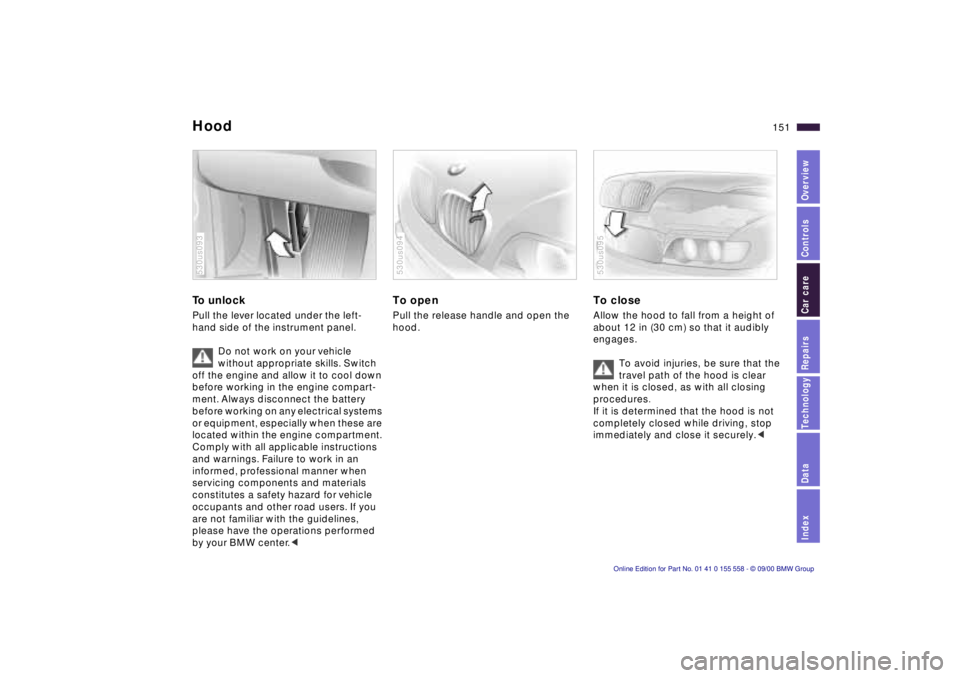
IndexDataTechnologyRepairsCar careControlsOverview
151n
HoodTo unlock Pull the lever located under the left-
hand side of the instrument panel.
Do not work on your vehicle
without appropriate skills. Switch
off the engine and allow it to cool down
before working in the engine compart-
ment. Always disconnect the battery
before working on any electrical systems
or equipment, especially when these are
located within the engine compartment.
Comply with all applicable instructions
and warnings. Failure to work in an
informed, professional manner when
servicing components and materials
constitutes a safety hazard for vehicle
occupants and other road users. If you
are not familiar with the guidelines,
please have the operations performed
by your BMW center.< 530us093
To open Pull the release handle and open the
hood. 530us094
To close Allow the hood to fall from a height of
about 12 in (30 cm) so that it audibly
engages.
To avoid injuries, be sure that the
travel path of the hood is clear
when it is closed, as with all closing
procedures
.
If it is determined that the hood is not
completely closed while driving, stop
immediately and close it securely.< 530us095
Page 152 of 223
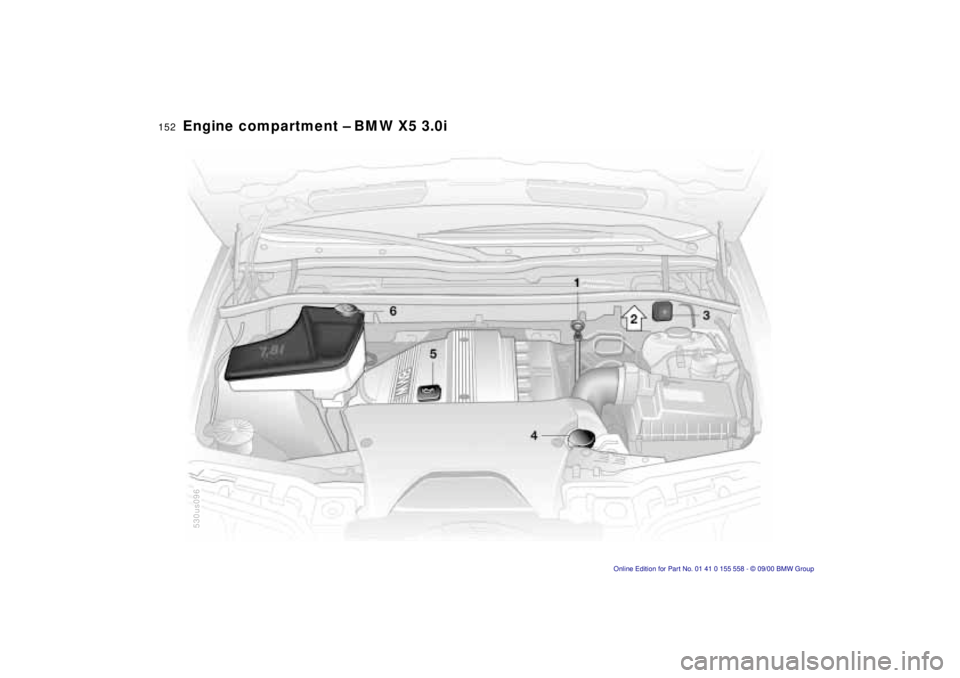
152n
530us096
Engine compartment – BMW X5 3.0i
Page 153 of 223

IndexDataTechnologyRepairsCar careControlsOverview
153n
Engine compartment – BMW X5 3.0i1 Engine oil dipstick157
2 Reservoir for brake fluid
(under the microfilter
trim panel)161
3 Auxiliary terminal for jump
starting190
4 Coolant expansion tank160
5 Engine oil filler neck157
6 Reservoir for windshield and
headlamp washer system
*
156
Page 154 of 223
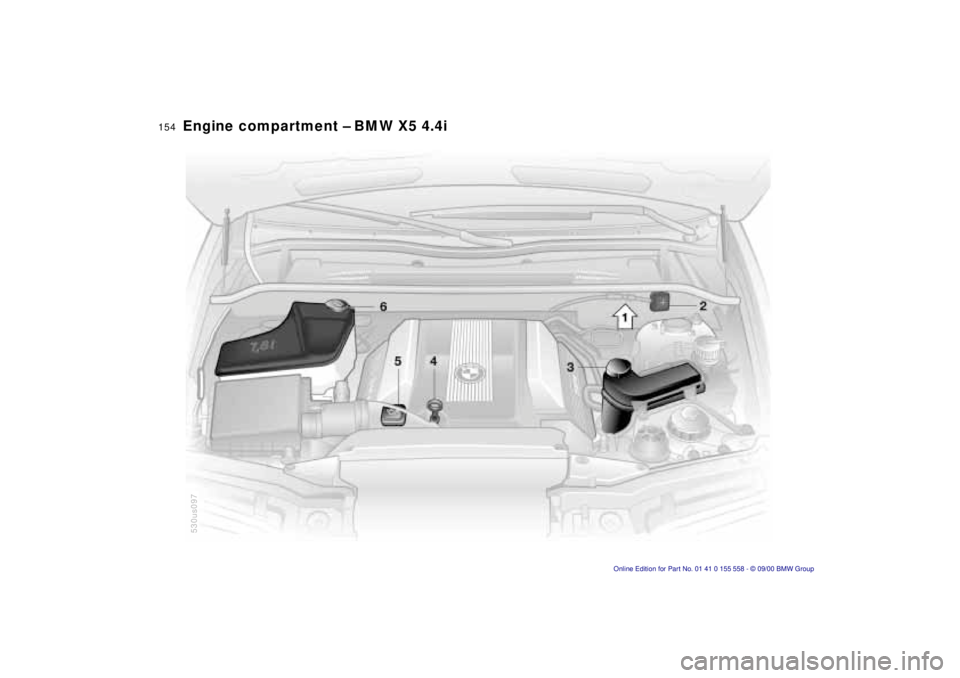
154n
Engine compartment – BMW X5 4.4i
530us097
Page 155 of 223

IndexDataTechnologyRepairsCar careControlsOverview
155n
Engine compartment – BMW X5 4.4i 1 Reservoir for brake fluid
(under the microfilter
trim panel)161
2 Auxiliary terminal for jump
starting190
3 Coolant expansion tank160
4 Engine oil dipstick157
5 Engine oil filler neck157
6 Reservoir for windshield and
headlamp washer system
*
156
Page 156 of 223
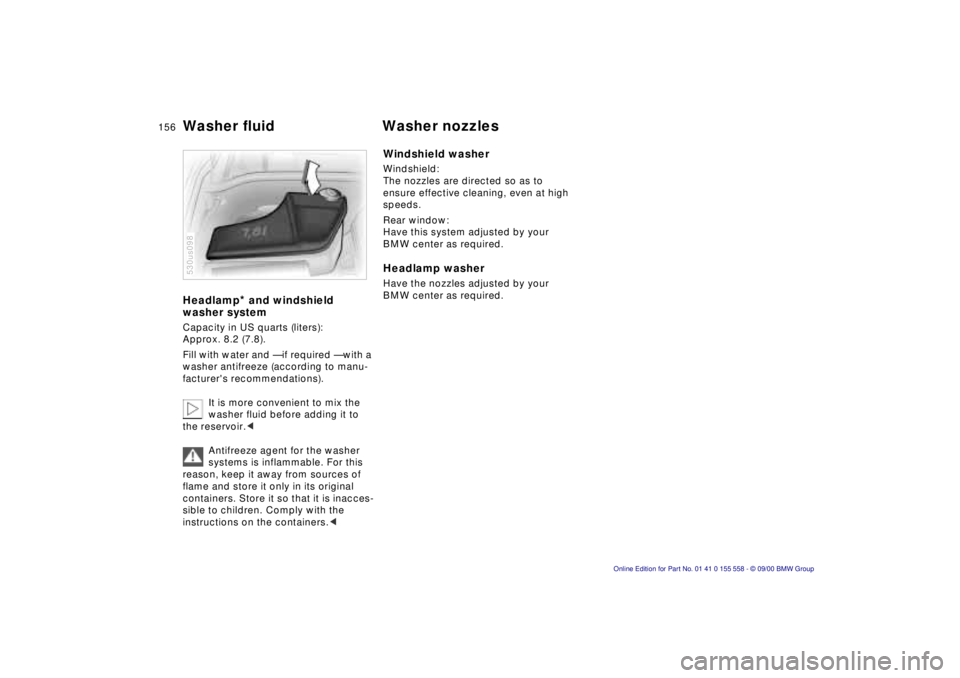
156n
Washer fluid Washer nozzlesHeadlamp
* and windshield
washer system
Capacity in US quarts (liters):
Approx. 8.2 (7.8).
Fill with water and — if required — with a
washer antifreeze (according to manu-
facturer's recommendations).
It is more convenient to mix the
washer fluid before adding it to
the reservoir.<
Antifreeze agent for the washer
systems is inflammable. For this
reason, keep it away from sources of
flame and store it only in its original
containers. Store it so that it is inacces-
sible to children. Comply with the
instructions on the containers.<530us098
Windshield washer Windshield:
The nozzles are directed so as to
ensure effective cleaning, even at high
speeds.
Rear window:
Have this system adjusted by your
BMW center as required. Headlamp washerHave the nozzles adjusted by your
BMW center as required.
Page 157 of 223
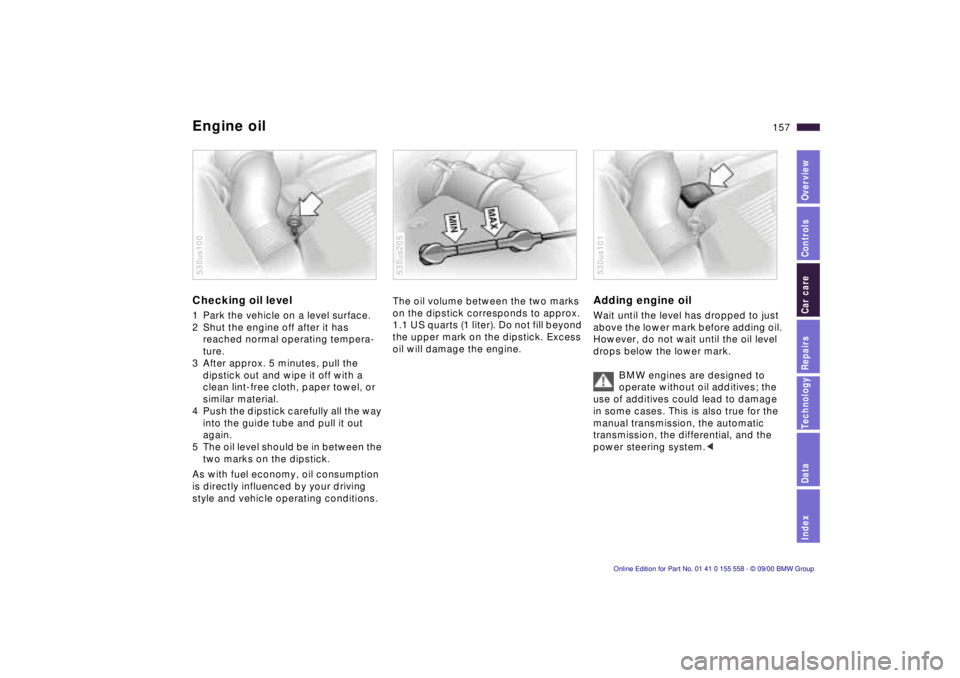
IndexDataTechnologyRepairsCar careControlsOverview
157n
Engine oilChecking oil level1 Park the vehicle on a level surface.
2 Shut the engine off after it has
reached normal operating tempera-
ture.
3 After approx. 5 minutes, pull the
dipstick out and wipe it off with a
clean lint-free cloth, paper towel, or
similar material.
4 Push the dipstick carefully all the way
into the guide tube and pull it out
again.
5 The oil level should be in between the
two marks on the dipstick.
As with fuel economy, oil consumption
is directly influenced by your driving
style and vehicle operating conditions. 530us100
The oil volume between the two marks
on the dipstick corresponds to approx.
1.1 US quarts (1 liter). Do not fill beyond
the upper mark on the dipstick. Excess
oil will damage the engine.530us205
Adding engine oilWait until the level has dropped to just
above the lower mark before adding oil.
However, do not wait until the oil level
drops below the lower mark.
BMW engines are designed to
operate without oil additives; the
use of additives could lead to damage
in some cases. This is also true for the
manual transmission, the automatic
transmission, the differential, and the
power steering system.< 530us101
Page 158 of 223
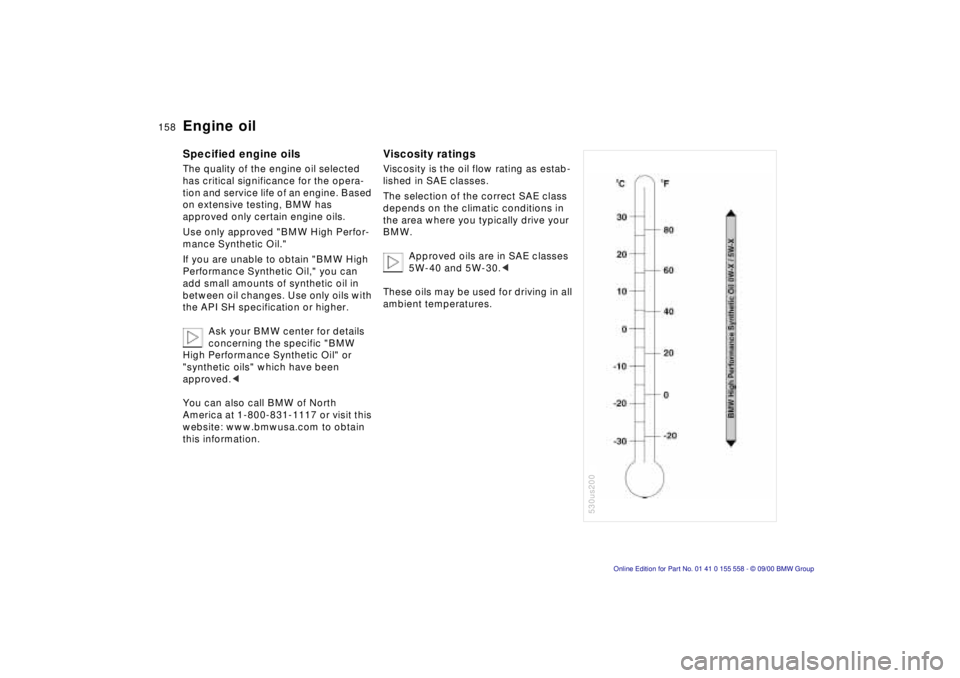
158n
Engine oilSpecified engine oils The quality of the engine oil selected
has critical significance for the opera-
tion and service life of an engine. Based
on extensive testing, BMW has
approved only certain engine oils.
Use only approved "BMW High Perfor-
mance Synthetic Oil."
If you are unable to obtain "BMW High
Performance Synthetic Oil," you can
add small amounts of synthetic oil in
between oil changes. Use only oils with
the API SH specification or higher.
Ask your BMW center for details
concerning the specific "BMW
High Performance Synthetic Oil" or
"synthetic oils" which have been
approved.<
You can also call BMW of North
America at 1-800-831-1117 or visit this
website: www.bmwusa.com to obtain
this information.
Viscosity ratingsViscosity is the oil flow rating as estab-
lished in SAE classes.
The selection of the correct SAE class
depends on the climatic conditions in
the area where you typically drive your
BMW.
Approved oils are in SAE classes
5W-40 and 5W-30.<
These oils may be used for driving in all
ambient temperatures.
530us200
Page 159 of 223

IndexDataTechnologyRepairsCar careControlsOverview
159n
Engine oil
Comply with the applicable envi-
ronmental laws regulating the
disposal of used oil.<
Recommendation: have the oil changed
by your BMW center.
Continuous exposure to used oil
has caused cancer in laboratory
testing. For this reason, any skin areas
that come into contact with oil should
be thoroughly washed with soap and
water.
Always store oils, grease and similar
materials so that they are inaccessible
to children. Comply with warning labels
and information on containers.<
Page 160 of 223
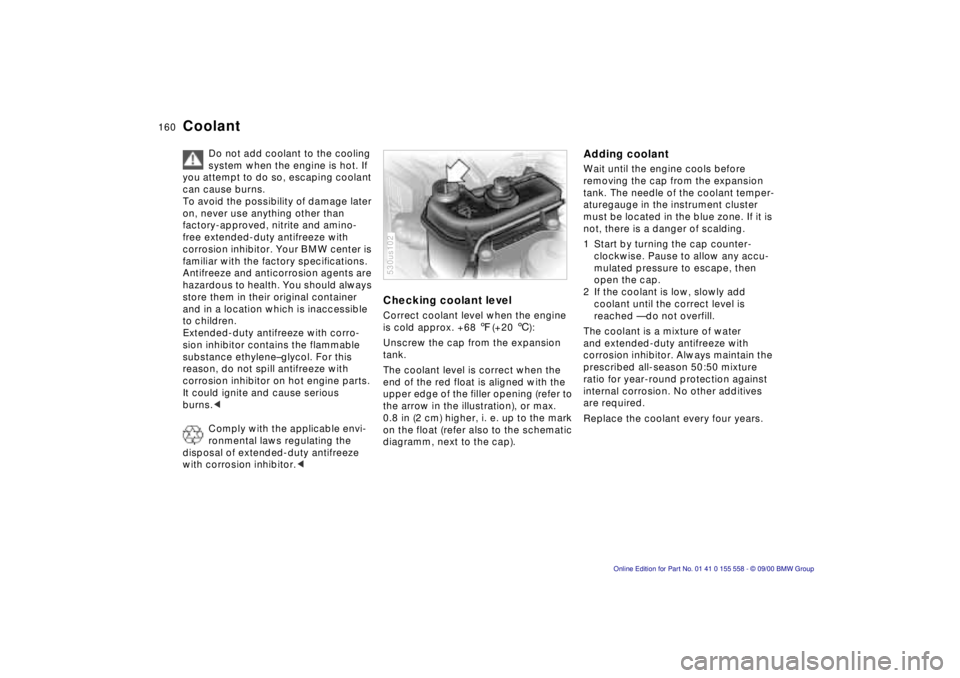
160n
Coolant
Do not add coolant to the cooling
system when the engine is hot. If
you attempt to do so, escaping coolant
can cause burns.
To avoid the possibility of damage later
on, never use anything other than
factory-approved, nitrite and amino-
free extended-duty antifreeze with
corrosion inhibitor. Your BMW center is
familiar with the factory specifications.
Antifreeze and anticorrosion agents are
hazardous to health. You should always
store them in their original container
and in a location which is inaccessible
to children.
Extended-duty antifreeze with corro-
sion inhibitor contains the flammable
substance ethylene–glycol. For this
reason, do not spill antifreeze with
corrosion inhibitor on hot engine parts.
It could ignite and cause serious
burns.<
Comply with the applicable envi-
ronmental laws regulating the
disposal of extended-duty antifreeze
with corrosion inhibitor.<
Checking coolant levelCorrect coolant level when the engine
is cold approx. +68 7(+20 6):
Unscrew the cap from the expansion
tank.
The coolant level is correct when the
end of the red float is aligned with the
upper edge of the filler opening (refer to
the arrow in the illustration), or max.
0.8 in (2 cm) higher, i. e. up to the mark
on the float (refer also to the schematic
diagramm, next to the cap).530us102
Adding coolant Wait until the engine cools before
removing the cap from the expansion
tank. The needle of the coolant temper-
aturegauge in the instrument cluster
must be located in the blue zone. If it is
not, there is a danger of scalding.
1 Start by turning the cap counter-
clockwise. Pause to allow any accu-
mulated pressure to escape, then
open the cap.
2 If the coolant is low, slowly add
coolant until the correct level is
reached — do not overfill.
The coolant is a mixture of water
and extended-duty antifreeze with
corrosion inhibitor. Always maintain the
prescribed all-season 50:50 mixture
ratio for year-round protection against
internal corrosion. No other additives
are required.
Replace the coolant every four years.